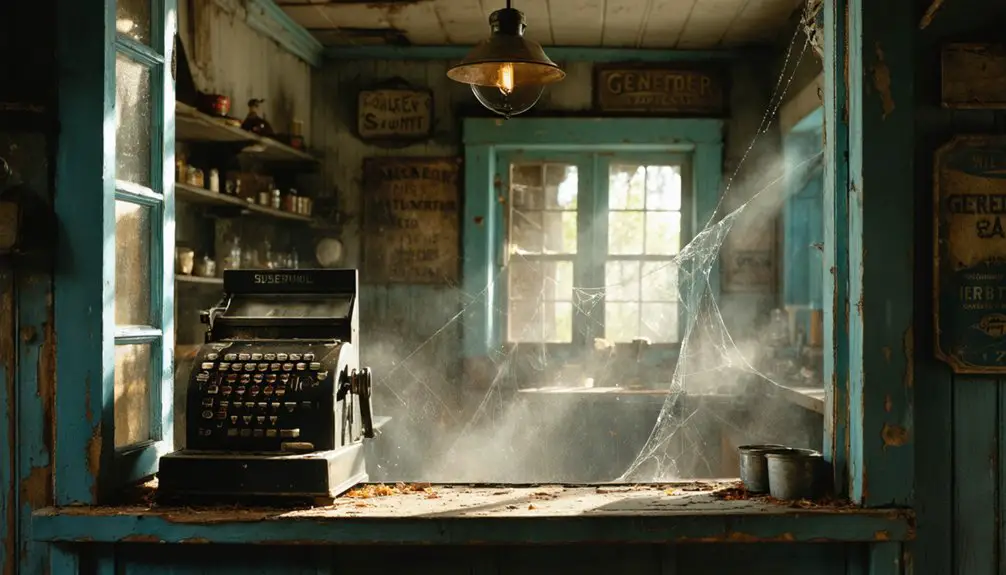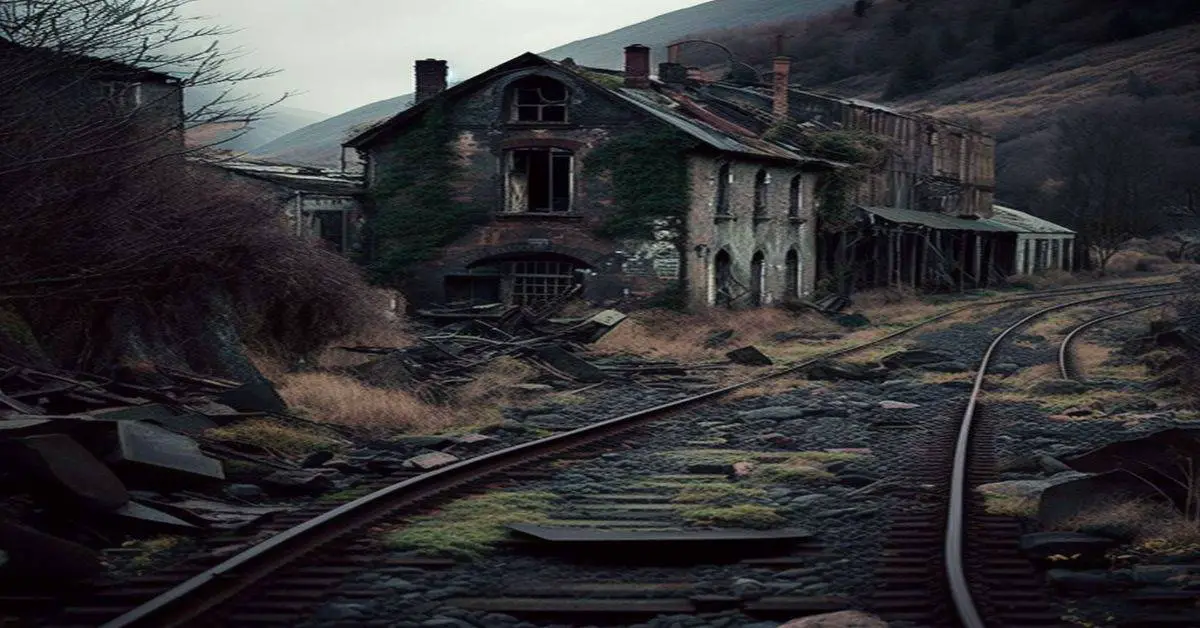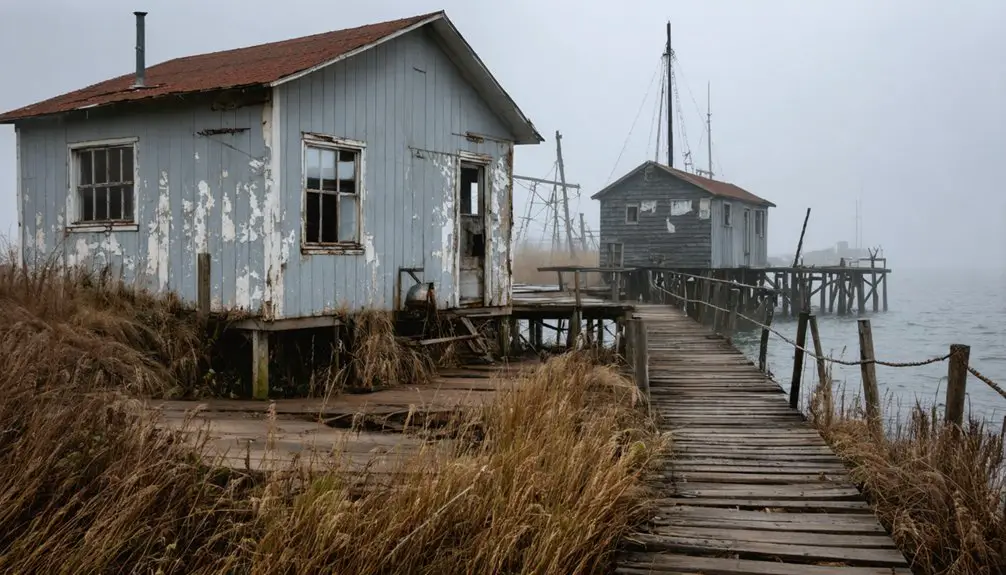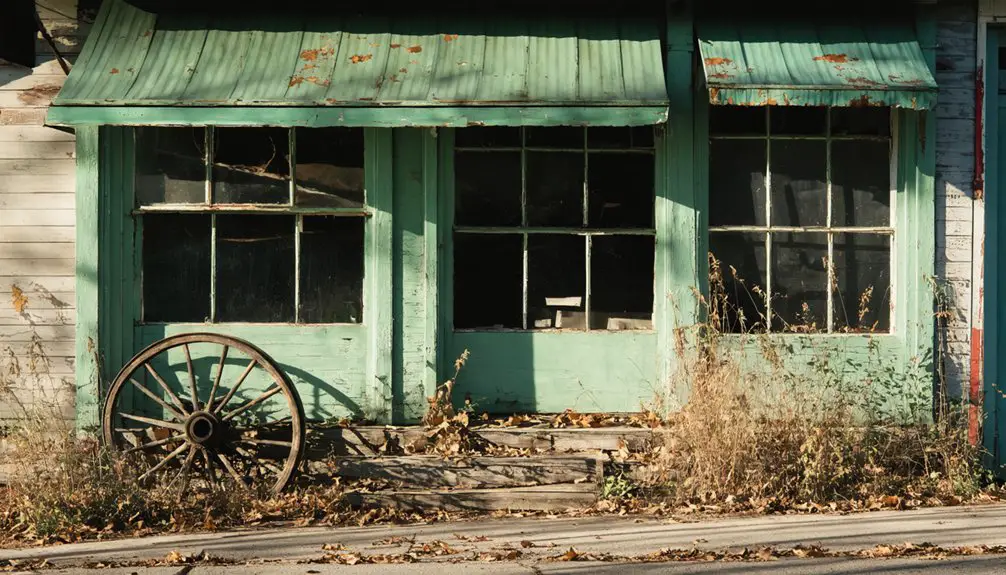You’ll find Aurora tucked away in northern Wisconsin’s Gogebic Range, where it flourished as a mining settlement in the late 19th century. The town generated an impressive $27 million in gold production during its peak, drawing nearly 10,000 fortune seekers to its wooden homes and bustling streets. After the Woolworth Fire of 1934 and dwindling ore deposits, nature reclaimed the land. While no structures remain today, Aurora’s supernatural legends and mining heritage continue to intrigue visitors.
Key Takeaways
- Aurora was a prosperous mining settlement in northern Wisconsin that thrived during the late 19th century due to iron ore discoveries.
- The town’s population peaked at nearly 10,000 residents during its mining boom, with immigrants primarily from Finland and Slovenia.
- Economic decline began when gold deposits became scarce, causing mass exodus following gold discoveries in Bodie.
- The devastating Woolworth Fire of 1934 destroyed much of Aurora’s remaining infrastructure, accelerating its abandonment.
- Today, Aurora exists only as a ghost town, with nature reclaiming the land and no physical structures remaining from its mining heyday.
The Rise of a Mining Settlement
As mineral deposits were discovered in northern Wisconsin during the late 19th century, Aurora emerged as a bustling mining settlement along the mineral-rich Gogebic Range.
You’d have found a diverse mix of prospectors, miners, and their families flocking to the area, bringing advanced mining techniques from their European homelands, particularly Finland and Slovenia. Much like the rush to Aurora, Nevada in 1861, fortune seekers raced to stake their claims in the promising territory.
The settlement’s rapid growth reflected the dynamic nature of mining boom towns, where you could witness the swift development of essential infrastructure. The discovery of ore in the Gogebic Range in 1872 sparked renewed interest in the region’s mining potential.
Rail lines and roads connected Aurora to major market hubs, while housing, commercial buildings, and social establishments sprouted up to serve the growing population.
The settlement dynamics were shaped by waves of immigrants who formed tight-knit ethnic enclaves, creating a culturally rich community united by the shared pursuit of mineral wealth.
Mining Operations and Economic Claims
The mining operations that defined Aurora’s economic landscape centered primarily on iron ore extraction within the mineral-rich Gogebic Range.
During the 1870s and 1880s, you’d have found small mining companies employing basic mining techniques, initially focused on local smelting before shifting to ore shipment eastward for processing. Similar to the Menominee Mining Company, early operations relied heavily on rich deposits of hematite ore.
- High-grade ore discoveries sparked intense but short-lived prosperity
- Economic fluctuations and resource depletion led to rapid decline
- External investors controlled capital, limiting local economic power
The town’s fate was sealed by its dependence on out-of-state financing and the discovery of more profitable deposits across the Michigan border. Similar to modern companies like Aurora Minerals which faced investor fund diversion allegations, the mining operations struggled with financial transparency issues.
Transportation costs cut into profits, with expensive infrastructure like the Sault Ste. Marie canal necessary for market access.
When ore deposits dwindled, investment capital quickly moved elsewhere, leaving Aurora’s mining companies to fail or close.
The Truth Behind Aurora’s Earnings
While most mining boomtowns generated modest profits, Aurora’s earnings reached an astounding $27 million in gold production during its peak years, making it one of Nevada Territory’s wealthiest frontier settlements.
At the height of the gold rush, you’d have found a bustling economy with nearly 10,000 fortune seekers flooding the area. The wealth wasn’t evenly distributed though – economic disparity was stark, with most profits concentrated among mine owners while laborers struggled. Famous author Mark Twain tried his luck prospecting in the area before moving on to other pursuits. Modern companies face similar financial challenges, as evidenced by Aurora Innovation’s $201 million loss in Q2 2025.
Life During the Peak Years
During Aurora’s most vibrant years, you’d have found a tight-knit community built around Wisconsin’s natural resource industries, with families living in modest wooden homes clustered near work sites. Just as the aurora borealis appears in bands across northern skies, the town’s neighborhoods formed distinct zones around industrial areas.
Family gatherings and cultural traditions shaped daily life, as residents came together in communal spaces to celebrate and support one another. Residents often shared stories about ghostly legends from nearby areas, passing down local folklore through generations.
- You’d spot neighbors meeting at the general store, sharing news and trading goods while children played nearby.
- Local churches and schools served as gathering points for seasonal festivals, where generations preserved their heritage through shared meals and storytelling.
- Social clubs and community events brought workers together after long days, fostering bonds through potluck suppers and holiday celebrations.
The rhythm of life centered around work, faith, and community, creating lasting connections that defined Aurora’s peak era.
The Swift Decline and Abandonment
As gold deposits became scarce in the late 19th century, Aurora’s once-promising future began to crumble beneath mounting economic pressures.
The discovery of gold in Bodie triggered a wave of economic migration as miners and investors abandoned Aurora’s depleted mines. You’d have witnessed the town’s desperate attempts at community resilience through a brief mining resurgence at the Magnum stamp mill, but this proved futile against the mounting challenges. By the end of the century, the town’s population drastically declined. Much like the mysterious Project Sanguine operations in Wisconsin, the area’s fate was sealed by government interventions.
When gold beckoned from Bodie’s hills, Aurora’s miners fled their barren claims, leaving only echoes of prosperity behind.
The devastating Woolworth Fire of 1934 delivered a crushing blow to Aurora’s remaining infrastructure.
With railroad routes bypassing the town and essential services vanishing, families had no choice but to relocate. The final exodus saw schools shuttered, businesses closed, and homes abandoned.
Nature slowly reclaimed the land, transforming this once-vibrant mining hub into another casualty of the American West’s boom-and-bust cycle.
Physical Remnants Today
Although Aurora once bustled with mining activity, today’s visitors will find little more than scattered foundations and overgrown remnants of this forgotten Wisconsin settlement.
Archaeological findings reveal a site that nature has largely reclaimed, with trees and vegetation obscuring what’s left of the town’s footprint.
- You’ll need to look carefully to spot the few surviving house foundations, which are mostly hidden beneath years of natural growth.
- There aren’t any maintained historical markers or signs to guide your ghost town exploration.
- The scattered brick and stone fragments you’ll encounter hint at the moderate development that once existed here.
The site’s barren condition and lack of intact structures suggest Aurora’s been abandoned for many decades, leaving only subterranean traces for historians to study.
Historical Significance in Wisconsin
Aurora’s brief but impactful role as a stagecoach stop and postal hub showcases southeastern Wisconsin’s essential early transportation networks before statehood.
You’ll find that Aurora’s rise and eventual absorption into Kenosha mirrors countless other frontier settlements that flourished temporarily along historic trade routes like the Green Bay Trail.
While no physical structures remain today, Aurora’s historical significance lives on through its contribution to Wisconsin’s early communication systems and its illustration of how pioneer communities shaped the state’s development.
Mining Era Impact
While many Wisconsin mining towns faded into history, Aurora’s legacy exemplifies the state’s vibrant 19th-century mineral extraction era. As part of Wisconsin’s mining heritage, Aurora emerged during the 1860s gold rush, attracting prospectors and entrepreneurs who sought their fortunes in the region’s rich mineral deposits.
- You’ll find evidence of ghost town dynamics in Aurora’s rapid rise and eventual decline, mirroring the boom-and-bust cycle common to mining settlements.
- The town’s infrastructure expanded quickly to support thousands of residents, with hastily built schools, stores, and saloons dotting the landscape.
- Aurora’s mining operations evolved from basic extraction methods to more sophisticated techniques as the mines deepened, though like many boomtowns, the prosperity wouldn’t last.
Economic Rise and Fall
Three distinct economic phases marked Aurora’s rise and fall in Wisconsin’s territorial history.
You’ll find Aurora’s initial prosperity rooted in early resource management, as settlers capitalized on the region’s timber, water sources, and fertile land. The town’s economic fluctuations mirrored many Wisconsin settlements, with agriculture forming its backbone through grain and dairy production.
The railroad’s arrival marked Aurora’s second phase, briefly transforming it into a vibrant trade hub. However, you’d soon see this advantage slip away as competing towns with better rail connections drew commerce elsewhere.
The final phase brought agricultural mechanization and failed industrial diversification attempts, which couldn’t sustain the town’s economy. Without sufficient capital investment or stable employment opportunities, Aurora’s population dwindled as residents sought opportunities in Wisconsin’s larger urban centers.
Preservation Through Time
Despite its physical decline, preservation efforts have kept Aurora’s legacy alive through a diverse collection of historical records and cultural initiatives.
You’ll discover the ghost town’s story through carefully preserved documents, archaeological findings, and local exhibits that showcase its mining heritage.
- County historical societies maintain extensive archives of maps, land deeds, and newspaper clippings that detail Aurora’s development and eventual abandonment.
- Archaeological surveys protect and document remaining building foundations and mining equipment, providing insights into frontier life.
- Rich ghost town folklore and settler tales are preserved through oral histories and annual reenactments that bring Aurora’s past to life.
Today, you can explore Aurora’s history through guided tours, museum exhibits, and interpretive markers that paint a vivid picture of Wisconsin’s mining era.
Myths and Legends of Aurora
Through the mists of time, Aurora’s supernatural legacy has woven itself deep into Wisconsin’s folklore.
You’ll find ghostly encounters centered around the Two Brothers Roundhouse, where shadowy figures and unexplained noises pierce the night’s silence. A little girl carrying a lantern haunts workers during closing shifts, while vengeful spirits make their presence known to visitors and employees alike.
The spectral legends intensified after the devastating Woolworth Fire of 1934, with restless souls reportedly lingering in places scarred by flame.
What began as a bustling stagecoach stop along the Green Bay Trail has transformed into a supernatural hotspot. While no physical traces of the original settlement remain, the area’s dark history lives on through ghost tours and paranormal investigations that draw curious visitors to this haunted corner of Kenosha County.
Preserving Aurora’s Legacy
You’ll find extensive historical documentation of Aurora through the Wisconsin Historical Society‘s meticulous preservation of maps, photographs, and census records that paint a vivid picture of this once-thriving settlement.
Local educational programs now bring Aurora’s story to life through guided tours of remaining foundations and carefully preserved artifacts that showcase the town’s rich cultural heritage.
The collection of community memories, including oral histories from descendants of original settlers, continues to enhance our understanding of daily life in this fascinating ghost town.
Historical Documentation Efforts
While Aurora’s physical structures have largely vanished, dedicated preservation teams have launched extensive documentation initiatives to safeguard the ghost town’s legacy for future generations.
Through thorough archival methods, you’ll find a wealth of materials being preserved, from land deeds and census records to newspapers and historic photographs. Community involvement has been essential, with local historical societies actively collecting oral histories from descendants and organizing preservation workshops.
- Archaeological teams use cutting-edge GPS and drone technology to map remaining foundations and artifacts.
- Local museums curate exhibits featuring salvaged domestic and industrial objects, with 3D scanning enabling virtual preservation.
- Digital archives provide global access to Aurora’s story through interactive websites and virtual tours of the historic landscape.
Educational Site Development
As preservation efforts continue to safeguard Aurora’s historical legacy, the development of an educational site has transformed the ghost town into a dynamic learning center.
Through adaptive reuse of historic buildings, you’ll discover modern educational spaces that honor the site’s architectural heritage while providing immersive learning experiences.
You’ll find interpretive signage throughout the grounds, offering insights into Aurora’s past through interactive displays and digital storytelling features.
The site’s development prioritizes accessibility for all visitors, incorporating sustainable design elements that protect both the environment and historical artifacts.
Local architects and historians have collaborated to guarantee every restoration detail maintains authenticity while supporting educational programs.
Whether you’re participating in archaeological workshops, exploring GIS mapping activities, or engaging with virtual reality tours, you’ll experience Aurora’s history in meaningful, hands-on ways.
Community Memory Collection
Despite the absence of physical structures, Aurora’s legacy endures through a dedicated community memory collection initiative.
You’ll find local historical societies actively gathering oral histories that paint vivid pictures of life around the Willis Tavern and along the Green Bay Trail. These stories capture the spirit of early Wisconsin settlement and preserve essential details about community life in the 1830s.
- Recorded memories from descendants of original settlers provide insights into daily routines and social gatherings
- Digital archives preserve genealogical records and maps that help pinpoint Aurora’s original location
- Community-driven documentation efforts collect and verify stories about the stagecoach service and post office operations
Through these collected memories, you’re able to connect with Aurora’s rich history, even though its physical traces have vanished from Kenosha County’s landscape.
Frequently Asked Questions
Were There Any Notable Crimes or Lawlessness Reported During Aurora’s Peak Period?
You won’t find reliable crime statistics or detailed law enforcement records, though local ghost stories and tour guides hint at isolated tragedies rather than widespread lawlessness during the town’s peak period.
What Indigenous Communities Lived in the Aurora Area Before Mining Began?
Did you know three Native tribes shaped this land’s cultural heritage? You’ll find the Menominee occupied it for 10,000 years, while the Outagamie and Winnebago tribes called these hunting grounds home too.
How Did Harsh Wisconsin Winters Affect Mining Operations in Aurora?
You’ll find winter hardships severely impacted mining, with frozen equipment, dangerous shaft conditions, and blocked transport routes causing frequent mining interruptions. Workers faced frostbite risks and reduced productivity in subzero temperatures.
Did Any Prominent Historical Figures Visit or Invest in Aurora?
You won’t find evidence of famous visitors or historical investments in Aurora’s brief existence. Records show the community remained locally focused, without attracting prominent figures or major outside investment.
What Specific Minerals or Metals Were Primarily Mined in Aurora?
Like veins of life beneath Earth’s skin, you’d find iron ore was Aurora’s primary treasure. High-grade iron minerals like magnetite, hematite, and goethite dominated mining, not copper deposits, during the 1880s boom.
References
- https://usghostadventures.com/aurora-ghost-tour/
- http://the-great-silence.blogspot.com/2011/12/aurora-ghost-town-odds-and-ends.html
- https://usghostadventures.com/haunted-stories/the-legend-of-doveland-wisconsin-the-vanishing-town/
- https://www.geotab.com/ghost-towns/
- https://www.youtube.com/watch?v=hyvSTpgwddA
- https://www.wisconsinhistory.org/Records/Article/CS410
- https://www.mineralcountymuseum.com
- https://en.wikipedia.org/wiki/Iron_Range
- http://sites.rootsweb.com/~wifloren/HISTORY_FLORENCE_COUNTY.html
- https://ironwoodmi.gov/history/



